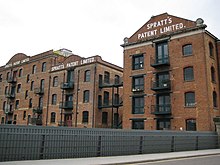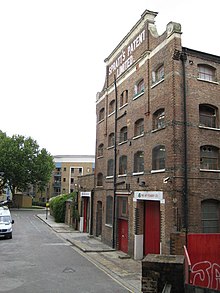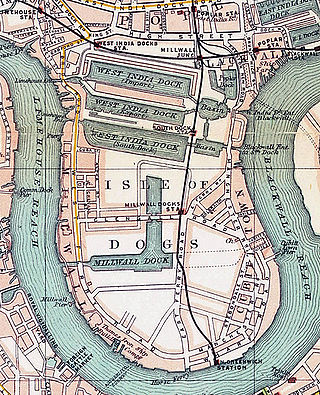
London Docklands is the riverfront and former docks in London. It is located in inner east and southeast London, in the boroughs of Southwark, Tower Hamlets, Lewisham, Newham, and Greenwich. The docks were formerly part of the Port of London, at one time the world's largest port. After the docks closed, the area had become derelict and poverty-ridden by the 1980s. The Docklands' regeneration began later that decade; it has been redeveloped principally for commercial and residential use. The name "London Docklands" was used for the first time in a government report on redevelopment plans in 1971 and has since been almost universally adopted. The redevelopment created wealth, but also led to some conflict between the new and old communities in the area.

Bermondsey is a district in southeast London, part of the London Borough of Southwark, England, 2.5 miles (4.0 km) southeast of Charing Cross. To the west of Bermondsey lies Southwark, to the east Rotherhithe and Deptford, to the south Walworth and Peckham, and to the north is Wapping across the River Thames. It lies within the historic county boundaries of Surrey. During the Industrial Revolution Bermondsey became a centre for manufacturing, particularly in relation to tanning. More recently it has experienced regeneration including warehouse conversions to flats and the provision of new transport links.
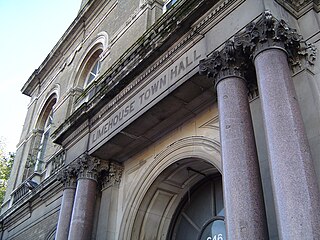
Limehouse is a district in the London Borough of Tower Hamlets in East London. It is 3.9 miles (6.3 km) east of Charing Cross, on the northern bank of the River Thames. Its proximity to the river has given it a strong maritime character, which it retains through its riverside public houses and steps, such as The Grapes and Limehouse Stairs. It is part of the traditional county of Middlesex. It became part of the ceremonial County of London following the passing of the Local Government Act 1888, and then part of Greater London in 1965. It is located between Stepney to the west and north, Mile End and Bow to the northwest, Poplar to the east, and Canary Wharf and Millwall to the south, and stretches from the end of Cable Street and Butcher Row in the west to Stainsby Road near Bartlett Park in the east, and from West India Dock and the River Thames in the south to Salmon Lane and Rhodeswell Road in the north.

Poplar is a district in East London, England, now part of the London Borough of Tower Hamlets. Five miles (8 km) east of Charing Cross, it is part of the East End.

Canary Wharf is an area of London, England, located near the Isle of Dogs in the London Borough of Tower Hamlets. Canary Wharf is defined by the Greater London Authority as being part of London's central business district, alongside Central London. With the City of London, it constitutes one of the main financial centres in the United Kingdom and the world, containing many high-rise buildings including the third-tallest in the UK, One Canada Square, which opened on 26 August 1991.

Castlefield is an inner-city conservation area in Manchester, North West England. The conservation area which bears its name is bounded by the River Irwell, Quay Street, Deansgate and Chester Road. It was the site of the Roman era fort of Mamucium or Mancunium which gave its name to Manchester. It was the terminus of the Bridgewater Canal, the world's first industrial canal, built in 1764; the oldest canal warehouse opened in 1779. The world's first passenger railway terminated here in 1830, at Liverpool Road railway station and the first railway warehouse opened here in 1831.

A digestive biscuit, sometimes described as a sweet-meal biscuit, is a semi-sweet biscuit that originated in Scotland. The digestive was first developed in 1839 by two Scottish doctors to aid digestion. The term digestive is derived from the belief that they had antacid properties due to the use of sodium bicarbonate when they were first developed. Historically, some producers used diastatic malt extract to "digest" some of the starch that existed in flour prior to baking.

Bromley, commonly known as Bromley-by-Bow, is a district in the London Borough of Tower Hamlets in East London, located on the western banks of the River Lea, in the Lower Lea Valley in East London.

The West India Docks are a series of three docks, quaysides and warehouses built to import goods from and export goods and occasionally passengers to the British West Indies on the Isle of Dogs in London the first of which opened in 1802. Following their commercial closure in 1980, the Canary Wharf development was built around the wet docks by narrowing some of their broadest tracts.

The Limehouse Cut is a largely straight, broad canal in the East End of London which links the lower reaches of the Lee Navigation to the River Thames. Opening on 17 September 1770, and widened for two-way traffic by 1777, it is the oldest canal in the London area. Although short, it has a diverse social and industrial history. Formerly discharging directly into the Thames, since 1968 it has done so indirectly by a connection through Limehouse Basin.

Narrow Street is a narrow road running parallel to the River Thames through the Limehouse area of east London, England. It used to be much narrower, and is the oldest part of Limehouse, with many buildings originating from the eighteenth century.
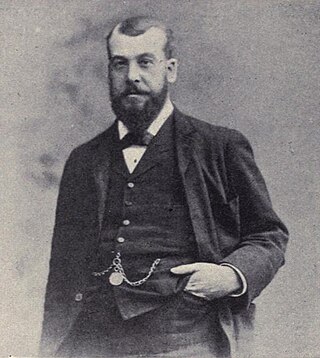
Charles Alfred Cruft was a British showman who founded the Crufts dog show. Charles first became involved with dogs when he began to work at Spratt's, a manufacturer of dog biscuits. He rose to the position of general manager, and whilst working for Spratt's in France he was invited to run his first dog show at the 1878 Exposition Universelle. After running dog shows in London for four years, he ran his first Cruft's dog show in 1891, and continued to run a further 45 shows until his death in 1938, as well as running two cat shows in 1894 and 1895. He was involved in a range of dog breed clubs, including that for Schipperkes, Pugs and Borzois. He and his wife upheld a story that they never owned a dog, and instead owned a cat, however Cruft admitted to owning at least one Saint Bernard in his memoirs, published posthumously.

Shad Thames is a historic riverside street next to Tower Bridge in Bermondsey, London, England, and is also an informal name for the surrounding area. In the 19th century, the area included the largest warehouse complex in London.
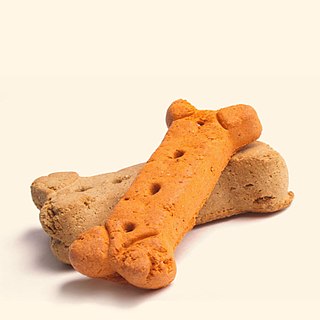
A dog biscuit is a hard, biscuit-based, dietary supplement for dogs or other canines, similar to human snack food.
Limehouse Studios was an independently owned television studio complex built in No. 10 Warehouse of the South Quay Import Dock. This was located at the eastern end of Canary Wharf in Limehouse near the Isle of Dogs in London, which opened in 1983. The building was demolished just six years later, in 1989, to make way for the Olympia & York development of Canary Wharf which now occupies the site. The opening of the studios was commemorated with a programme called Celebration which featured host Gary Wilmot and artists including Bonnie Langford.

Dundee Wharf is a residential development in Limehouse in the London Borough of Tower Hamlets in London. The modern buildings occupy the site of a former shipyard known as Limekiln Dockyard. John Graves established this shipyard in 1633 and then expanded his holdings with Dundee Wharf itself. By 1650 George Margetts developed a ropemaking yard including a ropehouse, storehouse and a ropewalk on the site. A modern wharf with electric cranes was constructed in the 1930s. This was used by the Dundee, Perth & London Shipping Company to operate a twice-weekly service between Perth, Dundee, Leith and London.

Spratt's was the world's first large-scale manufacturer of dog biscuits. The company successfully promoted their array of products for dogs and other domestic animals through the astute use of snob appeal. The company was the first to erect a billboard in London. Varieties of biscuits included 'Dog Cakes', puppy biscuits in regular and with cod liver oil, 'Malt-milk' for puppies, 'Weetmeet', 'Bonio', 'Spix', 'Ovals' in regular and mixed varieties, 'Fibo' granulated kibble food, 'Rodnim' hound meal, Alsax, Speedall, as well as a tinned food variety.
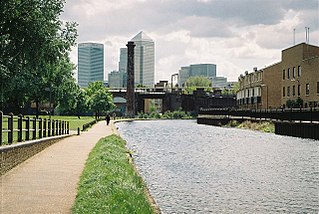
Bow Common was an area of common land, that lay on Bow Common Lane in what is now the London Borough of Tower Hamlets. Despite the name, the common lay just inside Mile End's parish boundary with Bromley by Bow, and not in the parish of Bow which was further to the north.

Old Granada Studios is a television studio complex and events venue on Quay Street in Manchester with the facility to broadcast live and recorded television programmes. The studios were formerly the headquarters of Granada Television and later ITV Granada from 1956 to 2013. After a period of closure, five of the six studio spaces were reopened under the All Studios banner in 2018. The studios are the oldest operating purpose-built television studios in the United Kingdom pre-dating BBC Television Centre by five years.

The Patera Building prototype, a significant example of British high-tech architecture, was manufactured in Stoke-on-Trent in 1982 by Patera Products Ltd. In 1980, Michael Hopkins architects and Anthony Hunt Associates engineers were instructed by LIH (Properties) Ltd to design a relocatable building 216 square metres in size.
